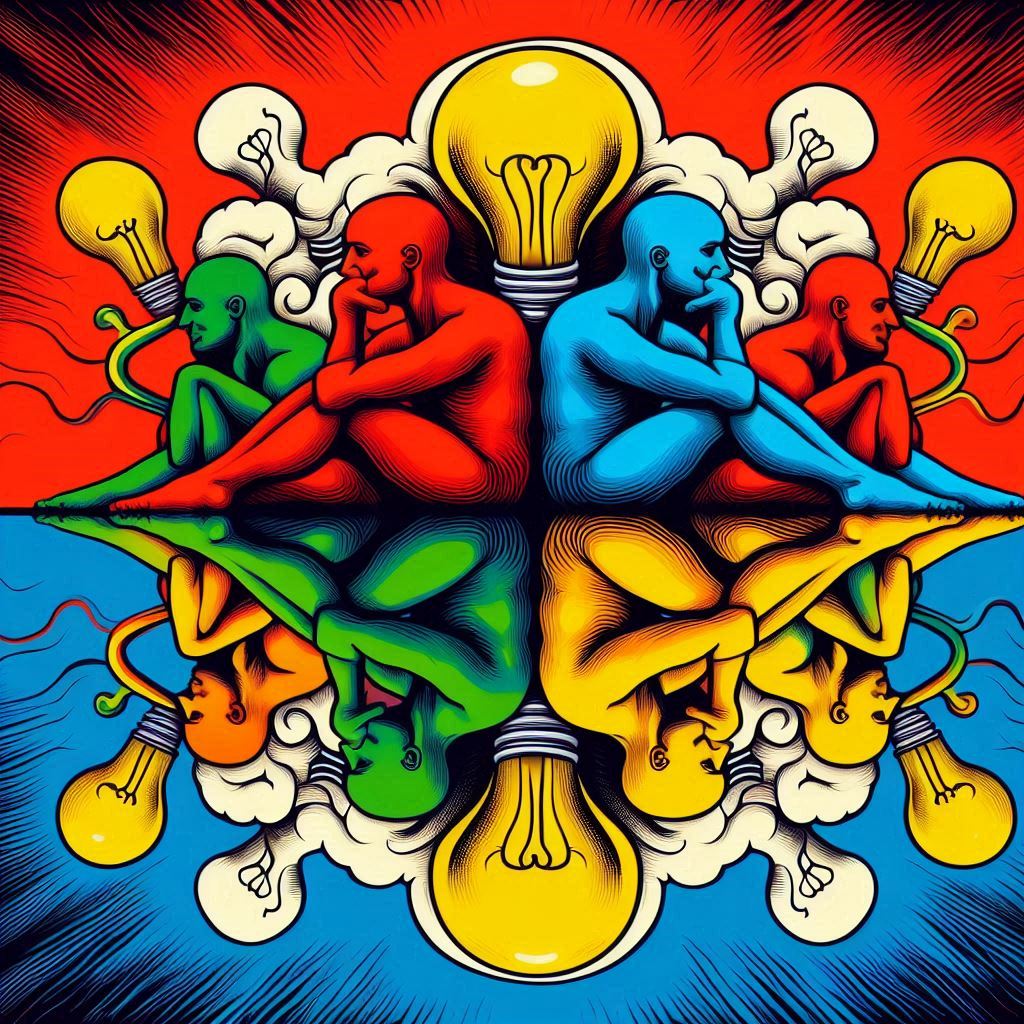Use Critical Thinking When Brainstorming
When brainstorming, it’s essential to think carefully to develop good ideas. Critical thinking means analyzing, evaluating, and reasoning through a problem or idea. This can help you find the best solution. Using critical thinking, you can avoid jumping to conclusions or settling for the first idea. Instead, you can discover new perspectives and opportunities.
In this article, we’ll discuss why critical thinking in brainstorming is helpful and how it can lead to better results.
The Fundamentals of Critical Thinking in Brainstorming
Establishing an Environment for Open Dialogue
Clear guidelines should be set for brainstorming sessions to encourage open dialogue and productive discussions. For instance, having a time limit allows equal participation and individual thinking time before group discussions. It’s important not to criticize others’ ideas during brainstorming to maintain an encouraging environment. After the session, assessing and categorizing the ideas and discussing the process as a group is crucial to maintaining an open dialogue.
This fosters creativity and leads to successful outcomes.
Setting Strategic Goals for Idea Generation Sessions
Strategic goals for idea-generation sessions should encourage the sharing of multiple ideas without fear of criticism or judgment. This will facilitate the free flow of ideas and ensure all perspectives are considered.
Setting a time limit for the brainstorming session will help optimize critical thinking by preventing mental fatigue and keeping the focus on idea generation.
Strategic goals can encourage open dialogue and exploration of multiple angles by focusing on organizing and categorizing ideas. This ensures all ideas are systematically presented, allowing for a more comprehensive analysis.
Emphasizing the importance of avoiding criticism and allowing rabbit trails will encourage exploring unconventional or tangential ideas, which can lead to breakthrough thinking.
Providing practical examples or case studies to illustrate how strategic goals have helped other organizations achieve successful brainstorming sessions can motivate participants and demonstrate the value of practical goal setting.
Techniques to Enhance Critical Analysis During Brainstorming
Question-led Ideation Approach

A question-led ideation approach enhances critical thinking during brainstorming sessions. It prompts participants to think deeply about the topic and explore different angles. For example, asking, “What would happen if we did the opposite of what’s expected?” encourages individuals to challenge assumptions and consider unconventional ideas.
The benefit of using provocative questions to guide idea generation is that they spark creativity and encourage participants to think outside the box. By asking questions like, “How might we solve this problem if resources were unlimited?” teams are pushed to stretch their imaginations and explore ambitious ideas.
Additionally, a question-led approach helps analyze ideas beyond the brainstorming session. It provides a framework for evaluating and refining concepts. For instance, questions such as “Does this idea solve the root cause of the problem?” enable teams to critically assess their ideas’ practicality and effectiveness.
Starbursting Strategy for Exploring Multiple Angles

The starbursting strategy is a helpful tool during brainstorming. It asks open-ended questions like “Who, What, When, Where, Why, and How” to explore different angles on a topic.
This technique encourages participants to provide detailed and thoughtful responses. It helps them consider various perspectives and comprehensively understand the topic.
When used in idea generation sessions, starbursting promotes thorough and structured thinking. It also fosters creativity and encourages active participation from all involved.
This strategy enhances critical analysis and thinking by addressing an idea’s fundamental questions. It requires participants to examine various dimensions of a concept or issue, leading to a more comprehensive exploration of multiple angles.
Reverse Thinking for Solutions

Reverse thinking is a great tool for coming up with new ideas. This method encourages people to look at problems from different angles, leading to creative solutions. By using reverse thinking in brainstorming, people are forced to question the norm and think outside the box. This helps in generating unique and effective solutions. It also encourages critical analysis and considering various possibilities.
By integrating reverse thinking, brainstorming becomes a place where diverse ideas are welcomed, resulting in unexpected outcomes. Setting time limits and organizing ideas ensures thorough consideration and evaluation of solutions. This method fosters a dynamic environment for idea generation and provides a structured way to evaluate and implement innovative solutions.
Silent Review: Sharing Thoughts without Pressure

The “Silent Review” technique can help create an open environment for idea generation. It allows individuals to contribute their thoughts without fear of criticism, fostering a non-intimidating space for brainstorming sessions. By encouraging sharing of ideas without verbal discussion, participants can engage in critical thinking and generate a wide range of ideas freely.
Additionally, the “Silent Review” approach in brainstorming sessions can lead to diverse creativity, as individuals are motivated to contribute more freely. This technique also facilitates organizing and categorizing ideas in a group setting, allowing for efficient idea sharing and contributing to a collaborative environment.
Collaborative Techniques for Group Brainstorming
Round Robin Sessions for Equal Participation

Round-robin sessions for equal participation in brainstorming offer numerous benefits to the entire team.
Firstly, they help to ensure that all team members have an equal opportunity to contribute their ideas. By allowing each person to speak, round-robin sessions eliminate the risk of louder or more dominant team members overshadowing the contributions of others. This fosters a fair brainstorming environment and ensures that diverse ideas and perspectives are heard. One effective strategy to encourage equal participation in round-robin sessions is to set a time limit for each person’s contribution. This ensures that everyone has an opportunity to speak, preventing any one person from monopolizing the discussion.
Additionally, writing down all ideas and organizing them into categories also promotes equal participation, as it allows all team members to see their ideas reflected and provides a visual representation of everyone’s contributions. With these strategies, round-robin sessions for equal participation can lead to more effective and inclusive brainstorming sessions.
Brain-netting: A Digital Approach to Idea Gathering

Brain-netting is a way to gather ideas using technology. It’s like traditional brainstorming but done digitally, letting people join from anywhere and share ideas in real time using tools like whiteboards and collaborative platforms.
One benefit of this approach is that it’s more accessible and inclusive, allowing people from different places to join simultaneously. But there’s a downside, too – technical issues and distractions can interrupt the session.
Critical thinking is important to making brain-netting effective. This means looking at ideas from different angles, checking for biases, and evaluating their validity. This helps ensure that the ideas are well-considered before being implemented.
The ‘Crazy 8s’ Fast-Sketching Method for Rapid Ideas

The ‘Crazy 8s’ fast-sketching method is robust for generating ideas during brainstorming sessions. Participants are given a piece of paper with eight blank squares and asked to sketch eight ideas quickly. This encourages quick thinking and bypasses self-censorship, promoting a non-judgmental environment and fostering creativity.
Using the ‘Crazy 8s’ fast-sketching method has many advantages. It helps break down mental barriers and push participants to think beyond the obvious, resulting in more diverse and innovative ideas. It also encourages visual thinking and aids in streamlining the brainstorming process by ensuring everyone’s ideas are documented and given equal consideration.
This method contributes to critical thinking by promoting rapid idea generation and facilitating the exploration of multiple possibilities. It allows for evaluating ideas based on merit rather than external factors, fostering a culture of open-mindedness and creativity in the brainstorming session.
Hybrid Brainstorming: Combining Synchronous & Asynchronous Sessions

Combining synchronous and asynchronous sessions in hybrid brainstorming has many advantages. Synchronous brainstorming allows real-time interaction, making building upon each other’s ideas more manageable. Asynchronous sessions offer more flexibility and time for individual contemplation. However, both methods also have their disadvantages.
Time zones may limit synchronous sessions, and participants may feel pressured to produce ideas on the spot. Asynchronous sessions can lead to delays and a lack of immediate feedback. Critical thinking is essential in both types of sessions.
During synchronous sessions, critical thinking can be fostered by setting clear guidelines for constructive feedback and encouraging open-mindedness. In asynchronous sessions, participants can engage in reflective thinking exercises and write down their thoughts before sharing them with the group.
Strategies such as setting time limits, holding discussions to encourage contemplation, and assigning designated facilitators can ensure that critical analysis is incorporated into both brainstorming sessions.
Asynchronous vs. Synchronous Ideation: Pros and Cons

Synchronous ideation happens in real time. It allows immediate feedback, engages participants, and enhances collaboration. However, it may pressure participants to respond quickly, potentially stifling innovative ideas.
On the other hand, asynchronous ideation lets participants contribute at their own pace, freeing them from time constraints and encouraging innovative thinking. But, the lack of immediate feedback may hinder idea-building and rapid problem-solving.
During brainstorming, synchronous ideation fosters active and energetic participation, encouraging spontaneous idea generation. In contrast, asynchronous ideation encourages thoughtful and reflective idea contributions.
Combining both approaches could significantly enhance the brainstorming process. For example, initial idea generation can be performed asynchronously, followed by a synchronous session to build upon and refine these ideas. This leverages the strengths of both methods, encouraging comprehensive critical thinking while maintaining a steady flow of ideas.
Critical Thinking Application in Different Types of Brainstorming
The Role of Facilitators in Asking Provocative Questions
Facilitators can help people think critically during brainstorming by asking thought-provoking questions. These questions challenge assumptions and encourage deeper analysis. For instance, they can prompt participants to consider different perspectives and approach problems from new angles. This fosters a culture of critical thinking and idea generation by inspiring participants to explore unconventional solutions and think creatively.
This allows facilitators to help participants uncover biases, question norms, and generate innovative ideas. Using thought-provoking questions in brainstorming can lead to more creative and effective problem-solving.
Analyzing Ideas: Beyond the Brainstorming Session
Applying critical thinking beyond brainstorming involves evaluating, interpreting, and synthesizing ideas. It helps identify underlying assumptions, implications, and consequences. Critical thinking encourages considering alternative perspectives, recognizing biases, and refining ideas through logical reasoning.
Techniques for enhancing critical analysis during brainstorming include setting a time limit to maintain focus, avoiding criticism of others’ ideas, and categorizing and organizing ideas for structured evaluation and decision-making. Best practices involve encouraging the generation of numerous ideas without pressure to produce brilliant solutions, allowing space for rabbit trails related to the topic, and ensuring all ideas are accessible and visible to all participants.
Using these methods, individuals can effectively employ critical thinking to analyze and refine ideas beyond the initial brainstorming session.
Mind Mapping Methods for Organizing Thoughts Critically
Mind mapping methods are valuable tools for organizing thoughts during brainstorming sessions. Mind maps visually represent ideas and their connections, enabling individuals to generate, expand, and structure their thoughts dynamically and non-linearly.
Critical thinking enhances the effectiveness of mind-mapping methods during brainstorming. It allows individuals to evaluate and analyze the relationships between ideas, identify potential biases, and consider multiple perspectives.
To effectively apply critical thinking in mind mapping, it’s important to encourage open and non-critical idea generation, set time limits to maintain focus, prevent mental fatigue, and organize ideas into different categories. This facilitates analysis and decision-making.
Brainstorming participants should be allowed to explore rabbit trails and return to the main topic, fostering flexibility and creativity.
Finally, it’s crucial to ensure that all ideas are documented and visible to all participants, enabling a collaborative approach to brainstorming.
Best Practices to Employ Critical Thinking in Brainstorming
Establishing Clear Guidelines for Productive Critical Discussions
It is very important to create clear guidelines for productive discussions during brainstorming sessions. Participants should feel free to suggest as many ideas as possible without feeling pressured to develop brilliant ideas. Criticizing others’ ideas should be off-limits, and it’s okay to go off-topic as long as the conversation eventually comes back to the main point.
It’s also helpful to allow individuals time to think before discussing ideas. To prevent mental exhaustion, the brainstorming session should last no more than an hour.
After the session, it’s crucial to assess the ideas critically. Documenting and organizing the ideas into categories can help identify the most promising ones and decide on a plan of action. For example, ideas about why stealing is wrong can be sorted into different groups to evaluate how productive the brainstorming session was.
Encouraging Individual Think Time Before Group Discussions
Encouraging individual thinking time before group discussions in brainstorming sessions is essential for maximizing idea generation. This can be done by setting a time limit for individuals to analyze their thoughts before joining group discussions.
For example, allowing participants a few minutes before the session to jot down their ideas independently can result in a more diverse and creative approach. When everyone can reflect on their ideas, it creates a more inclusive environment and leads to valuable contributions.
The benefits of individual thinking time before group brainstorming discussions include a wider variety of perspectives, increased participation from all members, and a more organized process. Also, group discussions will be more efficient and productive as participants have had the chance to organize their thoughts independently.
By implementing strategies to encourage individual thinking time, brainstorming sessions can become more effective and lead to innovative and creative ideas.
The Need for Follow-Up: Critical Assessment Post-Session
After a brainstorming session, it’s vital to assess the ideas generated. This helps the team reflect on strengths and weaknesses and determine the potential impact of those ideas.
Assessing the brainstorming process also helps evaluate its effectiveness. The team can examine whether the session achieved its goals and generated creative solutions.
To ensure actionable insights, the team can categorize and organize the ideas, identify common themes, and pinpoint areas for improvement.
By using these strategies, teams can learn from the session and make changes to enhance future brainstorming sessions.

Vizologi is a revolutionary AI-generated business strategy tool that offers its users access to advanced features to create and refine start-up ideas quickly.
It generates limitless business ideas, gains insights on markets and competitors, and automates business plan creation.


